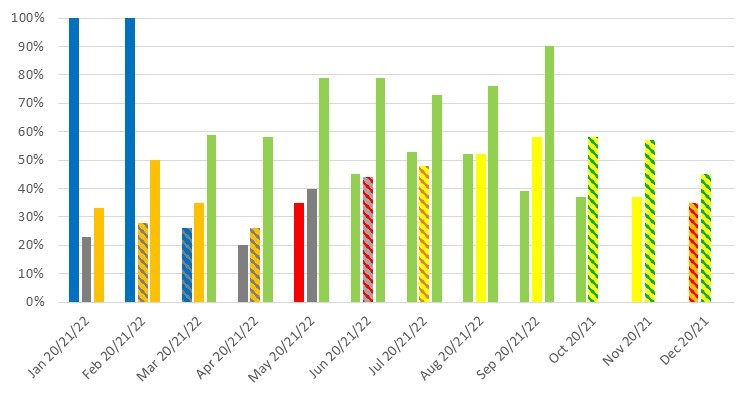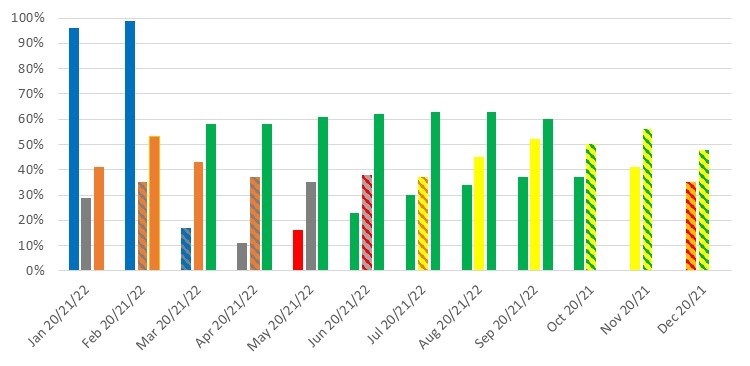Staff Report #1
September 28, 2022
To All Commissioners
Re: COVID-19 Ridership and Service Impacts
Recommendation
The report be NOTED and FILED.
Background
The pandemic declaration in March of 2020 and associated lockdown measures that have followed have resulted in declines in transit ridership on both the conventional and specialized services. Each new wave of the pandemic has resulted in varying levels of public health measures, including lockdowns in some cases. In addition to the impacts on ridership, London Transit has experienced numerous other issues that have impacted the ability to deliver service and work program initiatives as planned.
As the remainder of this report will illustrate, London Transit, consistent with transit systems across the country, finds itself if the eye of a perfect storm. While ridership levels are returning with many buses carrying standing loads, employee resource and supply chain issues are limiting the ability to increase service levels in response. The remainder of the report will discuss each of these elements in greater detail.
Conventional Transit
Ridership
The organizational philosophy adopted at the onset of the pandemic with respect to service levels was to ensure that all areas of the city that were served by transit would continue to be served, albeit at lesser frequencies based on employee resource availability.
The graph below provides an overview of the ridership levels on the conventional service for 2021 and 2022 to date with comparative data for 2020, both as a percentage of what would normally be expected in each month noting the numbers are based on actual boardings as counted by the automatic passenger counters on buses. The bars are coloured to match the various stages of lockdown as noted below:
Green Prevent – no, very limited restrictions in place
Yellow Protect & Stage 3 under the current re-opening plan – very limited restrictions in place
Orange Restrict & Stage 2 under the current re-opening plan – limited restrictions in place
Red Control & Stage 1 under the current re-opening plan – numerous restrictions in place
Grey Lockdown – full lockdown restrictions in place
The colour blue in the graphic is used for January and February 2020 given the pandemic declaration had not occurred at that point in time. Bars that are striped indicate a change during the month from the base colour to the striped colour.
2020, 2021 and 2022 Conventional Transit Weekday Ridership as a Percentage of Normal

The above graph clearly depicts the impacts that the various stages of lockdown have on conventional transit service ridership. As indicated in the graph, weekday ridership in September has reached approximately 90% of pre-pandemic levels. Weekend ridership continues to hover between 110% and 120% of pre pandemic levels.
The transition to fall service levels saw the return of Routes 90, 91, 94, 102, 104 & 106, which had been temporarily paused due to resource limitations. While these changes represent a significant increase in service levels compared to what was in place during the summer, the significant ridership increases in September, coupled with ongoing construction and related detours impacting numerous routes (See Staff Report #2 dated September 28, 2022) have resulted in significant overcrowding and schedule adherence issues across the system during the first few weeks of September. The most significant impacts experienced during this period have been on Routes 2, 9, 10, 17, 20, 27, 31, 33, 102 & 106. While this period traditionally brings heightened activity on the conventional service, resource limitations have impacted the ability to add tripper buses to help alleviate route specific issues as would traditionally be done. Ridership is being monitored on all routes on a daily basis and articulated buses are being assigned to the routes seeing the most crowding as the resources are available. As onboarding of new Operators continues and resources allow, tripper buses will also be utilized to help mitigate the impacts of the schedule adherence delays and provide additional capacity on crowded routes.
Employee Resource Requirements – Operations
Work continues with respect to the onboarding of Operators with a class of six recently completing training and a new class of five which began training on September 6, 2022. It is anticipated that classes of six will continue to run throughout the remainder of the year and into 2023. In addition to the need to hire Operators to increase complement, replacements are also required for those that will retire through the remainder of 2022 and in 2023. Additionally, a significant number of Operators will reach milestones in their tenure in 2023 which result in their entitlement to an additional week of vacation. An increase of three Operators to the overall complement will be required in 2023 to cover the lost time associated with the increased vacation entitlement.
Employee Resource Requirements – Fleet and Facilities
There are currently five skilled labour positions and three general service positions open and posted. There are currently no applicants for the skilled labour positions, and administration is in the process of reviewing applicants for the general service positions. In addition to the vacancies resulting from retirement, a number of employees in this department are also off work longer than what would be considered normal, primarily as the result of delays relating to the pandemic. These vacancies and absences have resulted in a significant reduction in available manpower and work is being prioritized in a manner that attempts to ensure that the required number of buses are available for service each day. Administration has realigned duties in the garage in an effort to enhance the workflow, and has also reached an agreement with the ATU local 741 to create two new apprentice positions, the details of which are currently being defined. While these steps are anticipated to help alleviate concerns with respect to ensuring the required number of buses are available for service each day, focus also remains on recruitment for the vacancies. LTC representatives from the Operations and Fleet & Facilities departments participated in the London area job fair on September 20, 2022, which provided the opportunity to speak directly to people interested in a potential career at London Transit.
Employee Resource Requirements – Administration
Resources in the administration area have been impacted throughout the pandemic, and were, for the most part managed through re-assignment of duties between roles. While this approach allowed operations to continue without major disruptions, work program initiatives were impacted, in some cases being deferred or delayed indefinitely. Given the small size of many departments, one absence can result in significant disruption, not only within that department, but other departments that may be relied upon to help fill the gap. The current labour market is also placing additional pressure on the administrative area as transit systems and consulting firms are desperately searching for employees at all levels with transit experience.
Supply Chain Issues
Over the past number of months, supply chain issues have, to varying extents, impacted the ability to service and maintain the conventional fleet, the majority of which have been resolved. The most significant issue outstanding is the delivery delay associated with the replacement and expansion buses for 2022, noting the entire order is not expected to be delivered until sometime in 2023. This delay is further compounding the manpower issues identified above noting each bus takes approximately 65 man-hours to be prepared for on-road service once it arrives. Delay of the delivery of the five expansion buses will also have a greater impact on service, as it will limit the ability to implement the 2022 service improvements until such time as the buses have been received and prepped for service.
Specialized Transit
Ridership
The graph below provides an overview of the ridership levels on the specialized service for 2021 and 2022 to date, with comparative data for 2020 as a percentage of what would normally be expected in each month.
2020, 2021 and 2022 Specialized Transit Ridership as a Percent of Normal

As the graph indicates, ridership levels to date for March through September 2022 surpassed the previous pandemic-period high from November 2021. Administration will continue to monitor trip demand by time of day and day of week, and gradually increase service hours to meet demand.
Service
As indicated above, administration is continuing to monitor service demand and will continue to work with the contracted service provider who has struggled with manpower issues, which resulted in the need to cancel daily runs on several occasions in the past few months. Unfortunately cancellations of this nature led to customer trips having to be rescheduled or cancelled, leading to missed medical appointments in some cases. Administration is continuing to work with the service provider to slowly increase service levels as their complement reaches levels they are confident they can maintain.
Corporate Communications
The corporate website, socials and stop-level notices will continue to be utilized, as appropriate, to provide up to date service information including service interruptions, detours etc. to keep customers informed with respect to current issues and plans going forward.
Internally, information screens will continue to be utilized to ensure that employees are informed of the issues being faced and the plans to address them.
A new on-board poster is in development which will remind riders that every available LTC employee is working tirelessly to deliver and increase service levels as efficiently as possible.
Recommended by:
Katie Burns, Director of Planning
Mike Gregor, Director of Finance
Craig Morneau, Director of Fleet & Facilities
Joanne Galloway, Director of Human Resources
Concurred in by:
Kelly S. Paleczny, General Manager